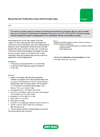-
US | en
- Contact and Support
- Technical Support
- Antibody Protocols
- Flow Cytometry
- Cell Activation Protocols
- Measuring Cell Proliferation using Cell Permeable Dyes

Measuring Cell Proliferation Using Cell Permeable Dyes
This method provides a general procedure for staining peripheral blood mononuclear cells with cell permeable dyes, prior to inclusion in activation and proliferation protocols such as FC15, FC16 and FC17. All blood samples must be collected into heparin anticoagulant as EDTA will interfere with the cell stimulation process.
This protocol is for use with the majority of Bio-Rad reagents. In some cases specific recommendations are provided on product datasheets, and these methods should always be used in conjunction with the product and batch specific information provided with each vial. A certain level of technical skill and immunological knowledge is required for the successful design and implementation of these techniques; these are guidelines only and may need to be adjusted for particular applications.
Reagents
- Phosphate buffered saline (PBS, cat. #BUF036A)
- CytoTrack™ Cell Proliferation Assay (#1351202-5)
- Cell media
Methods
- Isolate mononuclear cells using the appropriate methods, for example, for human peripheral blood refer to protocol FC2 Preparation of Human Peripheral Blood Mononuclear Cells, for mouse spleen refer to protocol FC3 Preparation of Peritoneal Macrophages, Bone Marrow, Thymus and Spleen Cells.
- Re-suspend at 0.5 x 106 cells in 500 µl PBS.
- Add 0.5-2 ml CytoTrack Assay to the cells. As a negative control DMSO can be added instead.
- Incubate at RT in the dark for 15 min.
- Wash cells in 5 ml of PBS.
- Resuspend in media.
- Incubate in the proliferation assay of choice for 48–96 hr.
- Transfer culture to FACS tubes and centrifuge at 300–400 g for 5 min.
- Remove supernatant and resuspend at 1 x 106. Perform surface staining as necessary.
-
Acquire data by flow cytometry.
Notes
Appropriate controls should be carried out for flow cytometry, consider including the following:
- Unstained cells (should always be included to monitor autofluorescence)
- Unstimulated control

